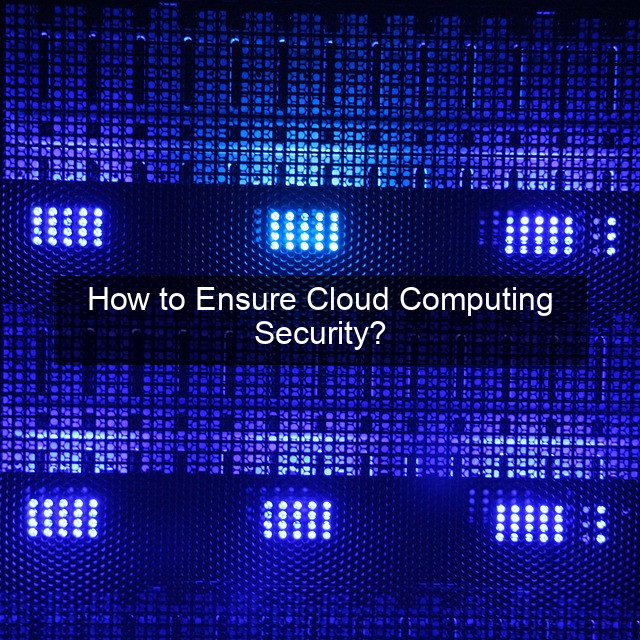How to Ensure Cloud Computing Security?

- How to Ensure Cloud Computing Security?
- How to Ensure Cloud Computing Security?
- Data Encryption and Access Control
- Implementing Strong Encryption
- Managing User Access
- Regular Security Audits
- Protecting Against Malware and Intrusions
- Intrusion Detection and Prevention Systems
- Regular Vulnerability Scanning
- Firewall Management
- Incident Response and Disaster Recovery
- Developing an Incident Response Plan
- Data Backup and Recovery
- Business Continuity Planning
- Choosing the Right Cloud Provider
- Security Certifications and Compliance
- Service Level Agreements (SLAs)
- Data Location and Sovereignty
- Frequently Asked Questions

How to Ensure Cloud Computing Security?
The cloud has revolutionized how businesses operate, offering unparalleled flexibility and scalability. However, this digital transformation brings new security challenges. Protecting sensitive data in the cloud requires a proactive and comprehensive approach. Simply migrating to the cloud doesn’t automatically guarantee security. Organizations must understand the shared responsibility model and implement robust security measures to mitigate risks and ensure data integrity. Ignoring cloud security can lead to devastating data breaches, financial losses, and reputational damage. This article delves into the essential strategies and best practices for ensuring robust cloud computing security.
Data Encryption and Access Control
Implementing Strong Encryption
Encryption is a cornerstone of cloud security. It transforms readable data into an unreadable format, protecting it from unauthorized access even if a breach occurs. Employing strong encryption algorithms for data at rest and in transit is crucial. Data at rest refers to data stored in databases or storage devices, while data in transit refers to data moving across networks. Robust encryption ensures that even if data is intercepted, it remains unintelligible to malicious actors.
Managing User Access
Controlling access to sensitive data is paramount. Implement the principle of least privilege, granting users only the necessary access rights to perform their duties. This minimizes the potential damage from compromised accounts. Regularly review and revoke unnecessary access privileges. Multi-factor authentication adds an extra layer of security, requiring users to provide multiple forms of identification before accessing sensitive information.
Regular Security Audits
Conducting regular security audits is essential for identifying vulnerabilities and ensuring compliance with security standards. These audits should assess the effectiveness of existing security controls and identify areas for improvement. Independent third-party audits provide an unbiased perspective and can uncover hidden weaknesses. Regular audits help organizations stay ahead of evolving threats and maintain a strong security posture.
Protecting Against Malware and Intrusions
Intrusion Detection and Prevention Systems
Intrusion detection and prevention systems (IDPS) are crucial for monitoring network traffic and identifying malicious activity. These systems can detect and block suspicious patterns, preventing intrusions before they cause significant damage. Real-time monitoring and alerts enable swift responses to security incidents. Integrating IDPS with other security tools enhances overall protection.
Regular Vulnerability Scanning
Regular vulnerability scanning helps identify weaknesses in cloud infrastructure and applications. These scans can detect known vulnerabilities and misconfigurations that could be exploited by attackers. Automated vulnerability scanning tools streamline the process and provide comprehensive reports. Addressing vulnerabilities promptly is crucial for minimizing the risk of successful attacks.
Firewall Management
Firewalls act as a barrier between your cloud environment and the outside world. Properly configured firewalls can block unauthorized traffic and prevent malicious actors from accessing your systems. Regularly review and update firewall rules to ensure they remain effective against evolving threats. Implementing both network-level and application-level firewalls provides comprehensive protection.
Incident Response and Disaster Recovery
Developing an Incident Response Plan
Having a well-defined incident response plan is crucial for effectively handling security incidents. This plan should outline the steps to be taken in the event of a breach or attack. It should include procedures for identifying, containing, and eradicating threats. Regularly testing the incident response plan ensures that it remains effective and that personnel are prepared to respond effectively.
Data Backup and Recovery
Regular data backups are essential for ensuring business continuity in the event of data loss or system failure. Backups should be stored securely in a separate location from the primary data center. Implementing a robust disaster recovery plan ensures that critical systems and data can be restored quickly in the event of a disaster. Regularly testing the disaster recovery plan is crucial for validating its effectiveness.
Business Continuity Planning
Business continuity planning goes beyond disaster recovery, encompassing a broader range of potential disruptions. It involves developing strategies to maintain essential business operations during unforeseen events. This includes identifying critical business functions, establishing recovery time objectives, and developing procedures for maintaining operations during disruptions. A comprehensive business continuity plan ensures resilience in the face of various challenges.
Choosing the Right Cloud Provider
Security Certifications and Compliance
When selecting a cloud provider, prioritize security certifications and compliance with industry standards. Look for providers that adhere to standards such as ISO 27001 and SOC 2. These certifications demonstrate a commitment to security best practices. Ensure the provider’s compliance aligns with your specific industry regulations and requirements.
Service Level Agreements (SLAs)
Carefully review the provider’s service level agreements (SLAs) to understand their responsibilities regarding security. SLAs should outline uptime guarantees, data protection measures, and incident response procedures. Clear SLAs provide a framework for accountability and ensure that the provider meets your security expectations.
Data Location and Sovereignty
Consider data location and sovereignty requirements when choosing a cloud provider. Data sovereignty regulations dictate where data can be stored and processed. Ensure the provider’s data centers comply with relevant regulations and your organization’s policies. Understanding data location is crucial for compliance and data protection.
| Security Measure | Description |
|---|---|
| Encryption | Protects data from unauthorized access. |
| Access Control | Restricts access to sensitive information. |
| Vulnerability Scanning | Identifies weaknesses in systems. |
- Implement strong passwords.
- Educate employees about security best practices.
- Stay updated on the latest security threats.
Frequently Asked Questions
What is the shared responsibility model in cloud security?
The shared responsibility model defines the security responsibilities of the cloud provider and the customer. The provider is responsible for securing the underlying infrastructure, while the customer is responsible for securing their data and applications within the cloud.
How can I protect against data breaches in the cloud?
Protecting against data breaches involves implementing strong security measures such as encryption, access control, intrusion detection, and regular vulnerability scanning. It also requires employee training and a robust incident response plan.
What are the benefits of using a cloud security provider?
Cloud security providers offer specialized expertise and tools for managing cloud security. They can help organizations implement best practices, monitor for threats, and respond to security incidents effectively.
Embracing a proactive and comprehensive approach to cloud security is no longer optional; it’s essential. By implementing the strategies outlined in this article, organizations can effectively mitigate risks, protect sensitive data, and ensure the long-term success of their cloud initiatives. The ever-evolving threat landscape demands constant vigilance and adaptation. Staying informed about emerging threats and best practices is crucial for maintaining a robust security posture in the cloud.




